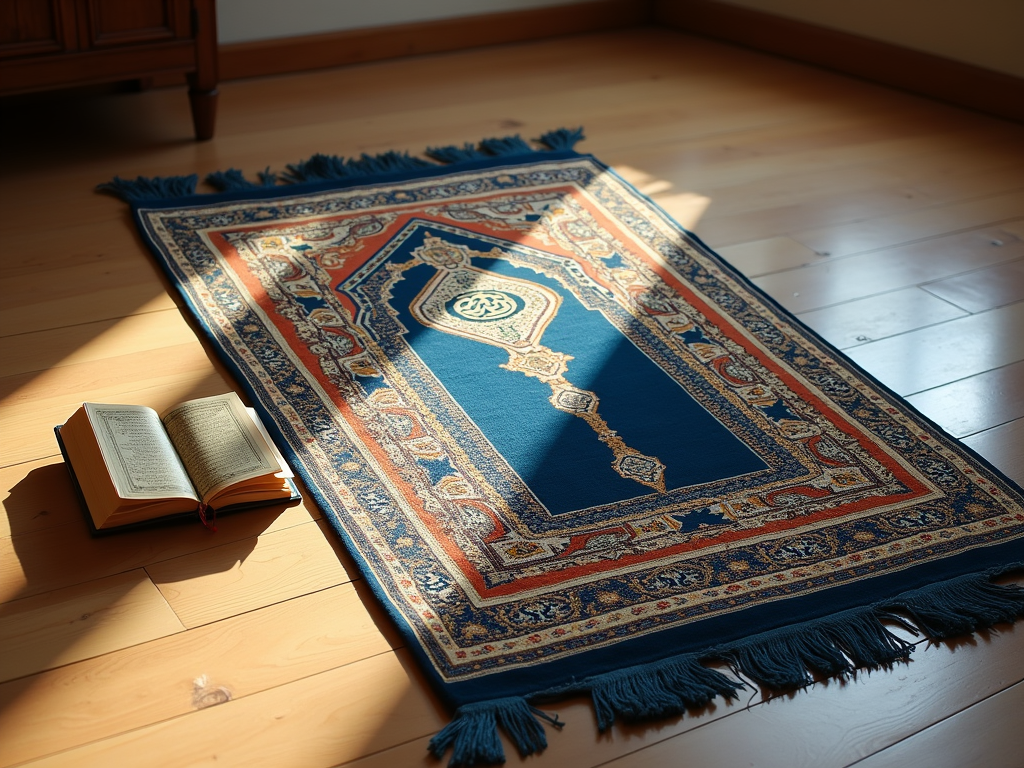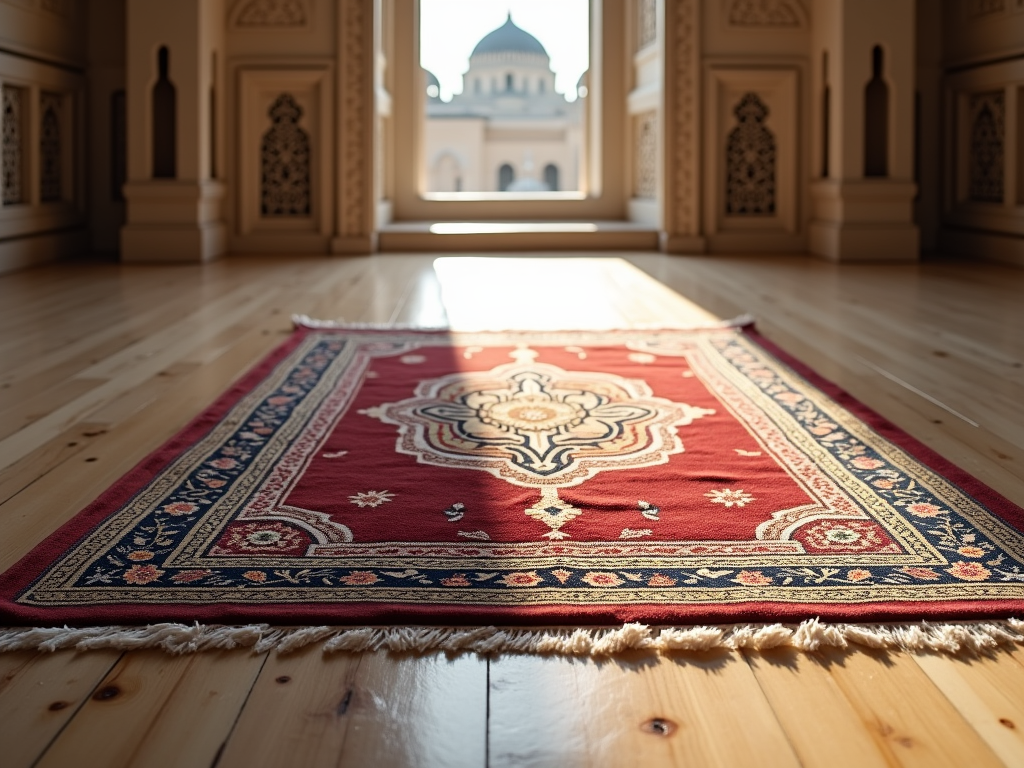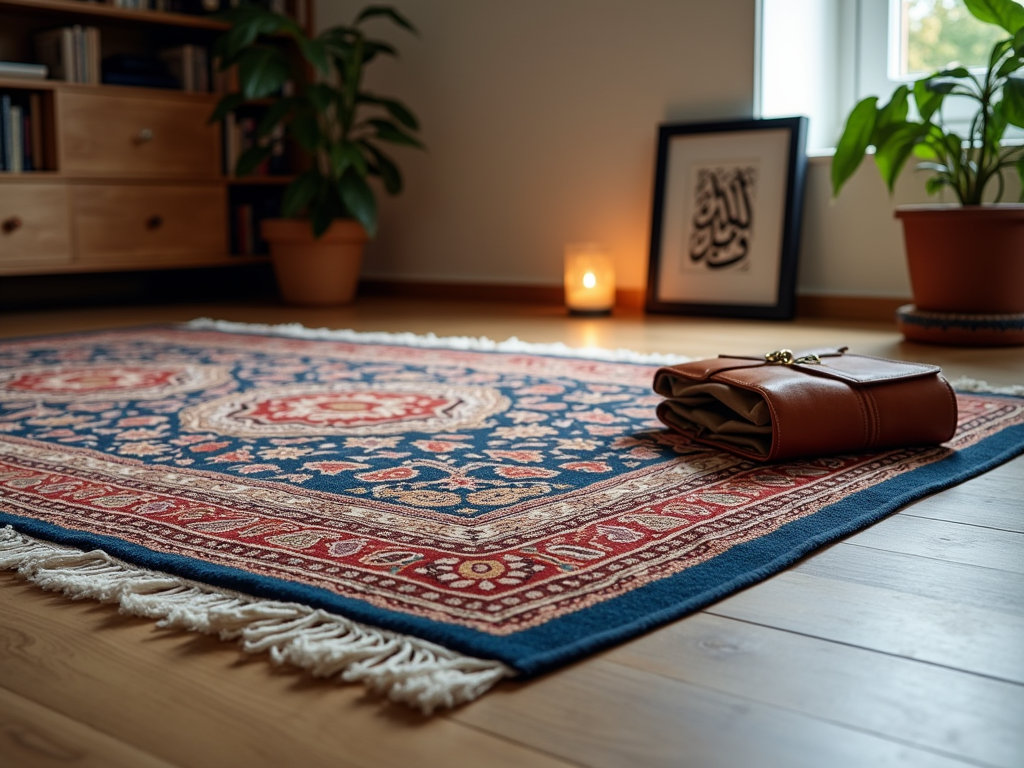
Islamic rugs serve as vital elements in Muslim homes, creating dedicated spaces for prayer while supporting traditional customs of floor seating. These masterful textiles have transformed from luxury items into fundamental household pieces, each region developing its signature style – from the flowing florals of Persian carpets to the bold geometry of Turkish Kilims.
Key Takeaways
- Prayer rugs (sajjāda) provide clean, portable surfaces for the five daily prayers and maintain ritual purity during worship.
- Islamic rugs feature specific design elements like the mihrab (arch) that points toward Mecca and patterns that help align the body.
- Regional styles such as Persian, Turkish, and Moroccan rugs each have distinctive patterns and cultural significance.
- Rugs serve multiple functions in Muslim homes, from dedicated prayer spaces to social gathering areas.
- The art of Islamic rug-making combines spiritual symbolism with practical functionality, resulting in pieces that are both beautiful and purposeful.
I see these pieces as more than decorative elements – they represent a perfect fusion of spiritual meaning and daily function. Each rug tells a story through its patterns and motifs, while serving essential roles in Muslim households. The careful placement of design elements, from the prayer niche to intricate borders, reflects centuries of artistic refinement and spiritual practice. These textiles create sacred spaces in any location, making them indispensable for Muslim families maintaining their faith and traditions.
The Sacred Space of Islamic Prayer
Prayer rugs hold deep religious and practical significance in Islamic worship. I’ve learned that while they aren’t mandatory for prayer, these special rugs create personal sacred spaces that Muslims can carry with them anywhere. The tradition of prayer rug origins can be traced through centuries of Islamic history.
Function and Purpose
The primary role of a prayer rug (sajjāda) is to provide a clean surface for the five daily prayers (Salat). Muslims need to maintain ritual purity during prayer, and these rugs act as a protective barrier between the worshipper and the ground. I’ve found that prayer rugs differ from standard decorative rugs in both their design and purpose.
Design Elements and Symbolism
Prayer rug designs aren’t random – they serve specific purposes in worship. Here are the key features that make these rugs special:
- A mihrab (arch) design that points toward the Kaaba in Mecca
- Patterns that help align the body in the correct prayer position
- Portable size for easy transport and storage
- Clean, dedicated space that can transform any location into a prayer area
The craftsmanship of these rugs has evolved into an art form, with skilled artisans developing techniques specific to prayer rug creation. Many of the finest examples come from regions with rich rug-making traditions, and it’s no surprise that certain countries have become famous for their prayer rug craftsmanship.
These rugs don’t just serve a practical purpose – they’re a physical representation of the sacred space created during prayer time. Much like other faiths use altars or shrines, Muslims use prayer rugs to establish a dedicated area for communion with Allah, regardless of their location.

From Status Symbol to Essential Home Decor
Cultural Significance and Practical Uses
I’ve noticed that rugs hold a special place in Muslim households, serving far beyond their religious purpose. While the rich history of rug making shows they started as status symbols for the wealthy, they’ve become essential items in Muslim homes across social classes. They create warm, inviting spaces that support traditional floor-seating customs and social gatherings.
The importance of rugs in Muslim culture extends into daily life. Traditional rug crafting techniques have been passed down through generations, with materials like wool, silk, and cotton chosen for their durability and comfort. These materials aren’t just practical – they create stunning pieces that transform living spaces into cozy retreats.
Regional Styles and Artistic Expression
Each region brings its unique touch to rug making. Persian rugs stand out globally for their intricate patterns and rich colors. Turkish Kilims catch the eye with their geometric designs, while Moroccan Beni Ourain rugs feature simple yet striking patterns that fit perfectly in modern homes.
Persian rugs differ from other styles in their detailed craftsmanship and symbolic patterns. Here’s what makes each regional style unique:
- Persian rugs showcase floral patterns and hunting scenes, often featuring deep reds and blues
- Turkish Kilims use bold geometric shapes and bright colors, perfect for both floor and wall display
- Moroccan Beni Ourain rugs feature natural wool colors and minimalist diamond patterns
- Prayer rugs include a mihrab (arch) design pointing toward Mecca
- Central Asian rugs often incorporate tribal patterns and symbols
These rugs do more than beautify spaces – they’re used for daily prayers, social gatherings, and floor seating during meals. Their practical benefits include insulation during cold months and comfort for traditional sitting arrangements. In many Muslim homes, you’ll find different types of rugs for various purposes, from dedicated prayer rugs to larger carpets for family areas.
The art of rug making continues to thrive in Muslim communities, with modern artisans adding contemporary twists to traditional designs. They’re creating pieces that honor cultural heritage while meeting today’s decorating needs.

The Art and Symbolism of Islamic Rugs
Sacred Patterns and Their Meanings
Islamic rugs stand as powerful expressions of faith and artistry, carrying deep spiritual significance in Muslim culture. These aren’t just floor coverings – they’re intricate canvases that tell stories through carefully chosen symbols and patterns. I’ve found that traditional Islamic rug designs originated from a unique blend of religious devotion and artistic expression.
The geometric patterns woven into these rugs reflect the Islamic appreciation of mathematics and order in creation. Intricate arabesque designs and infinitely repeating patterns symbolize the boundless nature of divine creation. Many rugs feature the Tree of Life motif, representing the connection between heaven and earth, while garden patterns serve as earthly glimpses of paradise.
Prayer Rugs and Cultural Heritage
Prayer rugs hold special significance in Islamic practice, featuring distinct elements that aid in daily worship. The most notable feature is the mihrab – an arch-shaped design that helps worshippers orient themselves toward Mecca during prayer. These prayer rugs have become so fundamental to Islamic culture that their invention marked a crucial point in rug-making history.
The art of creating these masterpieces has been carefully preserved across generations. Master weavers in places like Iran, Turkey, and Afghanistan have protected these techniques, making their regions famous for producing exceptional Islamic rugs. Each region has developed its signature styles and motifs, contributing to the rich tapestry of Islamic rug designs.
The artistic elements found in Islamic rugs include:
- Calligraphy featuring verses from the Quran or poetic texts
- Floral motifs representing the gardens of paradise
- Geometric patterns symbolizing unity and divine order
- Natural elements like water, birds, and trees
- Abstract designs that avoid depicting living creatures
These rugs serve multiple purposes in Muslim households, from sacred spaces for prayer to decorative pieces that enhance living areas. Their presence in homes reflects both practical needs and deeply held cultural values, creating spaces that are both functional and spiritually meaningful.
Ancient Trade Routes to Modern Markets
The Silk Road’s Influence on Rug Trading
The ancient Silk Road played a pivotal role in spreading the art of rug making across Islamic territories and beyond. I’ve found that the origins of rug weaving traditions can be traced through these historic trading routes, where merchants exchanged not just carpets but also techniques and cultural influences.
The invention of intricate rug-making methods spread rapidly through these trade networks, creating distinct regional styles. Each area developed its own signature patterns, weaving techniques, and color combinations. These unique characteristics made Islamic rugs highly valuable trading commodities.
Modern Market Evolution
Today’s market for Islamic rugs has transformed dramatically while maintaining its cultural significance. Several countries have earned fame for their rug craftsmanship, with each region’s pieces holding distinct value in the international market. Collectors particularly prize these textiles for their:
- Historical significance and cultural heritage
- Unique regional design elements
- Hand-knotted craftsmanship
- Natural dye usage
- Investment potential
The appreciation for Islamic rugs extends far beyond their practical use. Persian and other traditional area rugs have become prized pieces in art collections worldwide. Modern traders and collectors recognize these carpets as both functional art pieces and valuable investments, often fetching substantial prices at international auctions.
The enduring appeal of Islamic rugs in the global marketplace stems from their perfect blend of artistic excellence and practical utility. Contemporary rug makers continue these traditions while adapting to modern market demands, ensuring these cultural treasures remain relevant in today’s design landscape.
Adapting Tradition to Modern Life
Evolution of Prayer Rugs
Prayer rugs have transformed dramatically to fit contemporary Muslim lifestyles. The rich heritage of traditional rug making practices has adapted beautifully to meet modern needs. I’ve noticed that portable prayer rugs have become increasingly popular, especially among busy professionals and travelers. These compact versions fold easily into bags or briefcases while maintaining their essential purpose.
The mass production of prayer rugs has sparked significant changes in materials and manufacturing. While ancient rug making techniques relied exclusively on natural fibers, today’s prayer rugs often incorporate synthetic materials. This shift has made these important items more affordable and durable, allowing more Muslims to own multiple rugs for different locations and purposes.
Cultural Impact and Modern Usage
Prayer rugs now stretch far beyond their religious significance, becoming cherished pieces of home decor worldwide. The stunning patterns and designs from historically significant rug-producing regions have captured the attention of interior designers and art enthusiasts globally. I’ve seen how these rugs create meaningful focal points in modern homes while preserving cultural heritage.
For Muslims living in Western countries, prayer rugs serve as vital links to their cultural roots. They’re more than just decorative floor coverings – they’re portable pieces of home that can transform any space into a place of worship. Many Muslims keep multiple rugs in different locations:
- One at home for daily prayers
- A travel-sized version for work or travel
- Additional rugs for guests or family members
- Special rugs for community gatherings or religious celebrations

Sources:
Oriental Rugs: A Complete Guide – Charles W. Jacobsen
The World of Islam – Edited by Francis Robinson
Carpets from Islamic Lands – Friedrich Spuhler
Islamic Art – Jonathan Bloom and Sheila Blair
Rugs & Carpets of the World – Edited by Ian Bennett
Encyclopaedia Britannica – Articles on Islamic Art and Prayer Rugs
The Metropolitan Museum of Art – Collection of Islamic Art, including rugs and textiles
